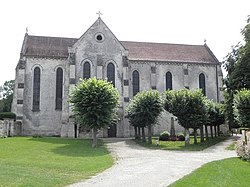Trosly-Breuil
Communes of OiseOise geography stubsPages with French IPA

Trosly-Breuil (French pronunciation: [tʁoli bʁœj]) is a commune in the Oise department in northern France. In 1964, Canadian Jean Vanier invited two men, Raphael Simi and Philippe Seux, to leave the institutions where they lived and live with him in Trosly-Breuil. Their time together led to the establishment of L'Arche at Trosly-Breuil, a community for people with disabilities to live with those who cared for them. Since that time L'Arche communities have been established in fifty countries around the world.
Excerpt from the Wikipedia article Trosly-Breuil (License: CC BY-SA 3.0, Authors, Images).Trosly-Breuil
Rue des Croisettes, Compiègne
Geographical coordinates (GPS) Address Nearby Places Show on map
Geographical coordinates (GPS)
| Latitude | Longitude |
|---|---|
| N 49.3992 ° | E 2.9678 ° |
Address
Rue des Croisettes 14
60350 Compiègne
Hauts-de-France, France
Open on Google Maps










